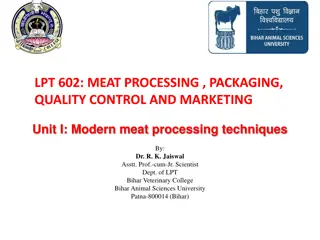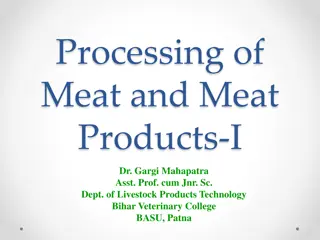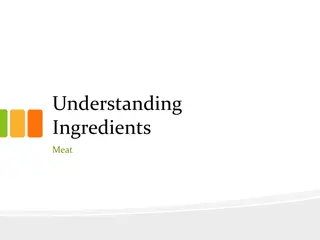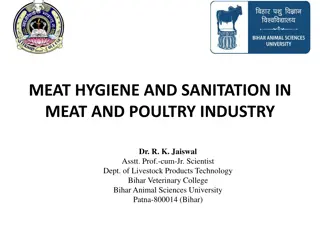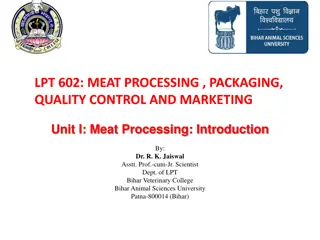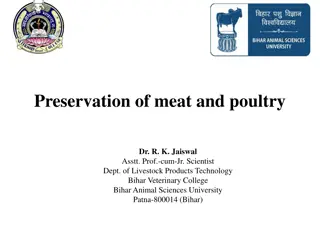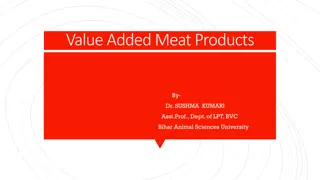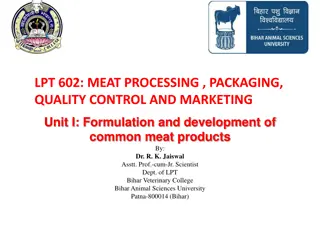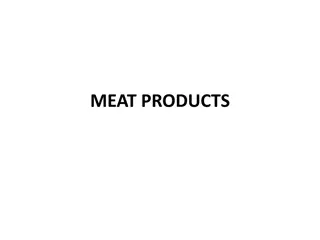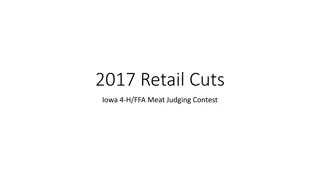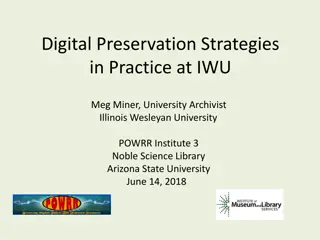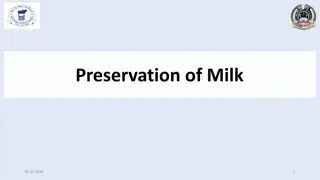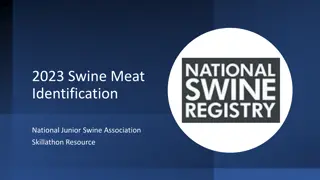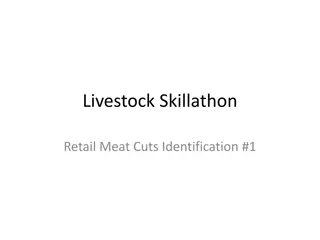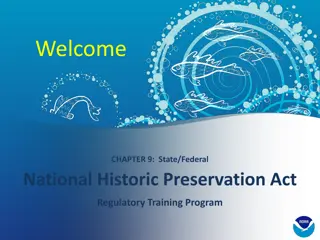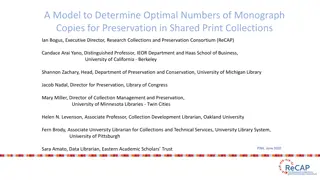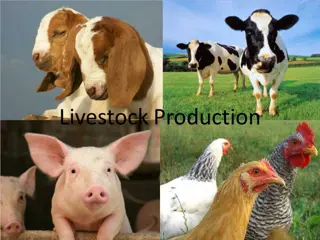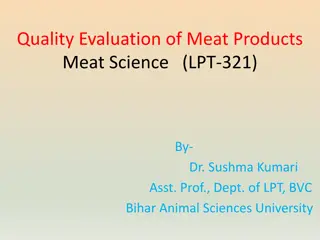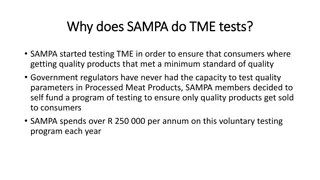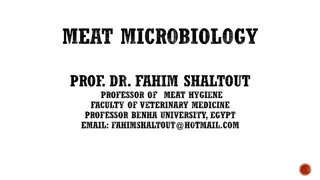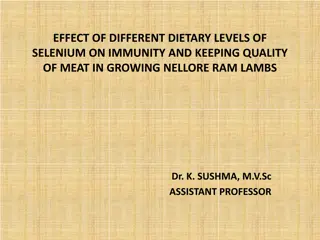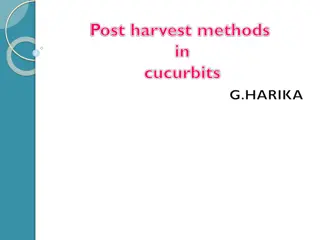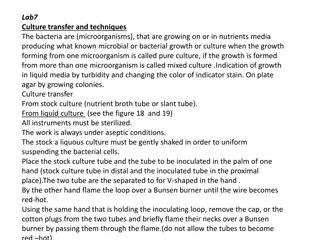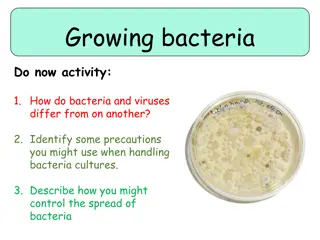Exploration of Meat Preservation Techniques from Various Cultures
This project delves into the science and tradition of meat safety and preservation, focusing on beef jerky as a counterpart to traditional Native American dried meats. It includes activities like preparing jerky, evaluating salt's impact on preservation, and sensory testing. Additionally, it explores meat preservation methods from different cultures, emphasizing the techniques of drying, curing, smoking, and the use of spices and herbs. Examples of dried meat from Africa, the Americas, and the Near East are also discussed.
Download Presentation

Please find below an Image/Link to download the presentation.
The content on the website is provided AS IS for your information and personal use only. It may not be sold, licensed, or shared on other websites without obtaining consent from the author. Download presentation by click this link. If you encounter any issues during the download, it is possible that the publisher has removed the file from their server.
E N D
Presentation Transcript
Science and Tradition of Meat Safety and Preservation. Deland Myers Sr. and Clifford Hall (NDSU) Mafany Mongoh (Sitting Bull College) Charles Morin (Four Winds Community School)
The Schedule 11:00-11:30 General organization/Cultural connection 11:30-12:00 Background about preservation methods and jerky/dried meat production 12:00-1:00 Activity 1 Preparation of jerky, place in dehydrator 1:00-1:30 Lunch 1:30-2:00 Activity 2 Impact of salt on meat preservation 2:00-2:30 Activity 3 Sensory Evaluation of dried meats 2:30-3:00 Wrap-up and Evaluation
Summary The project will focus on meat products similar to beef jerky, which is the counterpart to traditional Native American dry meats. The Sunday Academy will be divided into 4 parts. 1. Traditional meat preservation methods. 2. Role of Ingredient and drying as preservation methods. Preparation of jerky from beef, bison, deer, and elk. 3. Evaluation of samples with different levels of salt in jerky formulas. 4. Sensory testing of jerky (to be done outside of the lab).
Cultural Activity Traditional Native American Meat Preservation Meat Preservation from other cultures (e.g., Africa) http://www.fao.org/docrep/003/x6932e/X6932E02.htm
Meat Preservation from other cultures These developed techniques and procedures usually try to: Make the meat last longer Prevent spoilage, decay and microbial growth Have good flavor and taste better Have nice visually appealing color and structure Have an appealing odor or aroma
Meat Preservation from other cultures Most cultures have developed techniques and procedures for preserving meats that have been handed down for hundreds of years These techniques can typically be divided into: Drying Curing Smoking The use of spices, herbs, and additives Or a combination of any two techniques
Meat preservation from other cultures We are going to describe examples of dried meat or dried and further processed meat manufactured from several cultures from: Africa, Americas The Near East
Meat preservation from other cultures Odka (Somalia and other East African countries) A sun-dried meat product made of dry-salted lean beef It is often prepared from drought-stricken livestock. Qwanta (Ethiopia and other East African countries) Made from lean muscles of beef which are air-dried and lightly smoked Prior to drying, the strips are coated with a sauce containing a mixture of salt (25 percent), hot pepper/chili (50 percent) and aromatic seasoning substances (25 percent). Kilishi (Nigeria and other arid or semi-arid zones of West Africa) Made from sliced lean muscles of beef, goat meat or lamb produced by sun-drying thin slices of meat. It can be produced industrially using tray-drying in a warm air oven Some roasting is also done to add flavor
Meat preservation from other cultures Biltong (Southern African countries) A salted, dried meat prepared from beef or antelope meat. All muscles in the carcass may be used to make it But the finest biltong with the best flavor is made from the sirloin strip and the most tender is derived from the fillet Salt and pepper are the principal ingredients used. Other ingredients such as sugar, coriander, aniseed, garlic or other spices are used to improve flavor. Pastirma (Turkey, Egypt, Armenia) It is salted and dried beef from not too young animals. In some areas camel meat is also used. The meat is taken from the hindquarters and is cut into 50 to 60 cm long strips with a diameter of not more than 5 cm. The strips are rubbed and covered with salt and nitrate.
Meat preservation from other cultures Charque (Brazil and other South American countries) It consists of flat pieces of beef preserved by salting and drying. The pieces are submerged in a saturated salt solution for about one hour in barrels or cement vats. Soya (Cameroon and other West African countries) It consists of cube pieces of beef preserved by spices, roasting, and light drying on a stick or on papyrus paper. The pieces are submerged in a mixture of salt, garlic, pepper, and other spices for about one hour in barrels or deep containers.
Modern Meat Preservation U.S. Government definition of Jerky: A meat product (Ready-to-eat*) that can be whole or meat strips or ground and molded into a shape and dried (USDA, 2004). Moisture-to-protein ratio of 0.75 (or less) to 1 (Food Safety Inspection Service or FSIS, 2011) Final product water activity (aw) of 0.85 (FSIS 2012) Internal meat temperatures of 71.1 C (160 F) must also be achieved during processing
Modern Meat Preservation Definition: Preservation: any unit operation or step that reduces or prevents the deterioration of a food Food Safety: elimination of any hazard that can cause an illness if a food is consumed Deterioration and safety issues can be caused by: biological clostridium biotulinum microorganisms (bacteria, mold, etc.) bact-salmonella enzymes Chemical allergens and toxins
Modern Meat Preservation Methods use by food manufacturers to preserve food or to insure safety include : Temperature Osmotic Inhibition: drying ***The basis for jerky production*** Chemicals: curing, smoking, spices, herbs, and additives Irradiation Fermentation, etc. Hurdle effect (multiple methods)
Modern Meat Preservation Hurdle effect (technology)
Modern Meat Preservation Hurdle effect for jerky products Water activity (aw) of 0.85 Internal meat temperatures of 71.1 C (160 F) Addition of chemical preservatives Salt Sodium nitrite Citric acid Vacuum Packaging Storage in freezer/refrigerator (temperature hurdle) Storage under dry conditions
Modern Meat Preservation Homemade jerky production video http://www.youtube.com/watch?v=wp9To4L3s7A 1 1/2 to 2 pounds flank steak 2/3 cup Worcestershire sauce 2/3 cup soy sauce 1 tablespoon honey 2 teaspoons freshly ground black pepper 2 teaspoons onion powder 1 teaspoon liquid smoke 1 teaspoon red pepper flakes
Activity 1. Preparation of Jerkies Discussion regarding ingredients , drying, etc. preserve foods. http://www.foodnetwork.com/altons-beef-jerky/video/index.html The hands-on activity will involve preparing jerky. Beef, bison, deer, and elk Collect samples at intervals to monitor the changes in water activity and color Focus is on drying time as it relates to water activity and food safety of the product . Plot water activity over time Determine if meat and ingredients impacted water activity and color
Activity 2. Evaluate the impact of seasoning/salt on meat preservation Samples will be prepared at NDSU with varying season/salt levels and drying times. We will focus only on beef jerky in this activity. Hands-on Activity taste testing of samples (outside of the lab) measuring water activity and color observing samples for mold growth Outcome Understand the impact of partial drying and ingredients on the jerky quality and safety
Just About Right Test: Jerky Evaluation Sample Code ___________________ Please taste the jerky sample provided in cups. Make a check mark in the box that indicates how you feel about the product. You are free to check any of the boxes. Each sample will be evaluated on a separate sheet and there are a total of six (6) samples. Comments are welcome. Date __________________ Color: Too Brown Just About Right Too Red/Pink Texture: Too Soft Just About Right Too Tough
Activity 3. Sensory Evaluation of Dried Meats Samples will be prepared at NDSU with different meats used in activity 1. One formula will be used in the preparation. Hands-on Activity taste testing of samples (outside of the lab) we will have a discussion about how students rated the sample and we will reveal the meat source (samples from the reservations) measuring water activity and color (? if time permits) Outcome Understand the influence of meat source on the jerky quality
Sensory Evaluation of Beef Jerky SAMPLE NUMBER: _________________________ Please evaluate the bread sample for the following qualities: Flavor, Texture, Appearance and Overall Acceptability (i.e. liking). Make an X on the appropriate line. Please give comments in the space provided below each quality if desired. APPEARANCE: ----------- like extremely ----------- like very much ----------- like moderately ----------- like slightly ----------- neither like nor dislike ----------- dislike slightly ----------- dislike moderately ----------- dislike very much ----------- dislike extremely FLAVOR: ----------- like extremely ----------- like very much ----------- like moderately ----------- like slightly ----------- neither like nor dislike ----------- dislike slightly ----------- dislike moderately ----------- dislike very much ----------- dislike extremely COMMENTS: COMMENTS:
Analytical Methods Water Activity video
Analytical Methods Color Video


